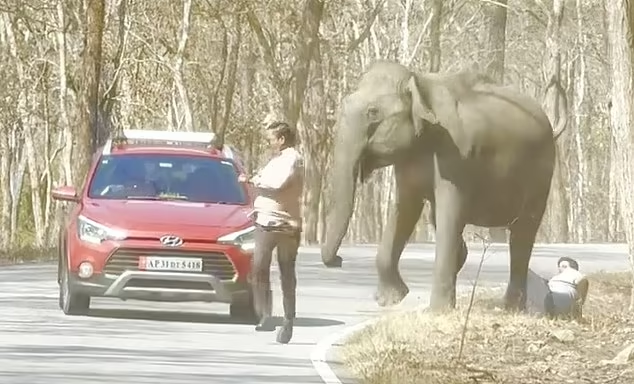A casual photo opportunity turned into a life-threatening wildlife encounter in Karnataka’s Bandipur forest, when two men stepped out of their car to take selfies and were suddenly charged by a wild elephant.
The incident — captured on video and now viral across social media — shows the terrifying speed and strength of a tusker defending its territory, and the shocking recklessness of tourists who underestimate nature.
The Dangerous Selfie Gone Wrong
The video opens with two men standing beside a parked car on a narrow forest road near the Karnataka–Kerala border. Bandipur National Park, a major tiger reserve, is known for its dense forests and roaming elephants. Despite repeated warnings from forest officials, some visitors continue to get out of their vehicles for photographs.
Moments after the men position their phones for a selfie, a massive elephant appears from the trees behind them. In a split second, it lowers its head, trumpets loudly, and charges.
Panic sets in. Both men sprint toward the car — but the elephant closes the gap in seconds. One of them stumbles, collapsing onto the dirt road. The elephant looms over him, tusks inches away, before abruptly slowing and turning back into the woods.
The man, shaken and bruised, survived by pure luck. Witnesses say the tusker could have crushed him in an instant.
Also Read: Man Loses 360 Pounds Naturally — Internet Rallies to Support His Next Step
A Viral Reminder of Nature’s Power
The footage, believed to have been filmed near the Bandipur–Wayanad Tiger Reserve, spread rapidly online. Viewers across India and beyond were both horrified and captivated — the clip served as a vivid reminder that the wild is not a backdrop for social media.
“The person is very lucky to have survived the elephant attack,” one user commented. Another wrote, “If you play with wildlife, you do not stand a chance. It’s just luck that he survived.”
Forest officials confirmed that one of the men sustained minor injuries but did not require hospitalization. Still, they emphasized how dangerously close the situation came to disaster.
“This kind of behavior puts both humans and animals at risk,” said a Bandipur ranger. “When people step out of vehicles, elephants feel threatened — and that’s when tragedy happens.”
The Bigger Picture: A Growing Man–Animal Conflict
The Bandipur region, stretching over 870 square kilometers, is one of India’s most vital conservation zones. It forms part of the larger Nilgiri Biosphere Reserve, which connects with Wayanad, Mudumalai, and Nagarhole — together creating a vast corridor for tigers, elephants, and countless other species.
But with that beauty comes risk. Human encroachment, increased tourism, and expanding roads through forest areas have brought people and wildlife closer than ever before.
In recent months, Karnataka has seen a rise in man-animal conflicts. Villagers near forest edges have reported elephants raiding crops, crossing highways, and even entering settlements in search of food.
To address the crisis, the state government has deployed special task forces to monitor elephant movements, install early-warning systems, and educate tourists about safe behavior in reserves.
Yet, as this latest video shows, education means little if visitors ignore common sense.
Related Reading: Science Confirms Kelly Brook’s Perfect Body — But the Real Message Is Bigger Than Beauty
When Curiosity Turns into Chaos
Elephants are intelligent, emotional creatures — capable of memory, empathy, and even grief. But they are also territorial. A startled elephant, especially a lone tusker or a mother with calves, can be unpredictable and deadly.
Experts believe the tusker in the video was likely agitated by noise or movement. “He wasn’t attacking out of aggression,” said a local wildlife biologist. “He was reacting to a perceived threat — protecting his space, as any wild creature would.”
Incidents like this often begin with curiosity and end in chaos. What seems like a harmless photo can provoke an instinctive defense response. And unlike a staged safari, there’s no second take when a six-ton elephant decides you’ve crossed the line.
Lessons from Bandipur
Tourists often treat protected forests as extensions of amusement parks — forgetting that the creatures within them don’t follow human rules. Bandipur’s forest roads are clearly marked with signs instructing visitors not to step out of their cars or feed animals. Rangers patrol the routes, but enforcement remains difficult given the park’s size and the growing number of visitors.
“The best photo,” one forest officer said, “is the one you take safely from your window.”
Despite campaigns warning against dangerous selfies, such incidents continue worldwide. From cliffs to zoo enclosures, thrill-seekers risk their lives for viral content. But as this clip proves, nature doesn’t pause for a good angle.
The Psychology of Risk
Behavioral experts say this “selfie culture” often overrides fear with the lure of digital attention. “When people think about how the photo will look, they stop thinking about the reality around them,” one psychologist explained. “It’s a form of tunnel vision — and in wildlife settings, that’s lethal.”
The irony is that what draws us to the wild — the rawness, the unpredictability — is exactly what makes it dangerous. Respecting that unpredictability isn’t fear; it’s wisdom.
A Warning, Not a Villain
The elephant in Bandipur wasn’t a villain. He didn’t hunt those men — he warned them. A loud trumpet, a mock charge, a retreat. It was nature setting boundaries.
And in that, there’s a lesson: wild animals shouldn’t have to die or be relocated for behaving naturally in their own home. The responsibility lies with visitors to honor those invisible lines.
Moving Forward
After the incident, Bandipur authorities are reportedly reviewing stricter safety measures — including surveillance cameras, fines for reckless behavior, and new visitor awareness programs.
The goal isn’t to restrict tourism, but to restore respect. Because when humans act carelessly, both species lose.
The Takeaway
As the viral video continues to circulate, the message grows clearer with every replay: wildlife deserves distance, not selfies.
Those few seconds between curiosity and chaos are often the difference between a story to tell — and a tragedy to regret.
For the two men in Karnataka, luck won out this time. But next time, it might not.
Because the forest isn’t a photo studio — it’s a living, breathing world that demands humility. And if we can’t walk through it with respect, we don’t deserve to walk through it at all.


